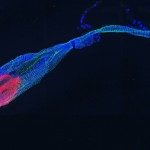Présentation
Synthetic peptides and conjugates thereof as potential antivirals (col. H. Lortat-Jacob (CEA, Grenoble), D. Bonnaffé (ICMMO, Orsay) A bi-substrate synthetic glycopeptide resulting from the covalent linkage between a CD4 peptide mimetic and a heparan sulfate (HS) dodecasaccharide was proposed as a new HIV entry inhibitor. The binding of the CD4 mimetic to gp120, induces a conformational change that exposes the CD4-induced epitope, which in turn is locked by the HS fragment. The covalent linkage between the CD4 mimetic and the polyanionic HS oligosaccharide provides powerful cooperative effects, resulting in strong antiviral activity towards both CCR5- and CXCR4-tropic HIV-1 strains when evaluated on PBMC. In the search for optimization and simplification, synthetic polyanionic peptides have been investigated as an alternative to HS fragments. A fully synthetic peptide conjugate – mCD4-P3YSO3 – was identified as a highly potent bi-substrate HIV entry inhibitor, which displays low-nanomolar activity against a number of clinical HIV-1 isolates, including representatives of clades A, B and C.
Lipopeptides for the specific detection of Mycobacterium avium paratuberculosis (Map) in paratuberculosis and Crohn’s disease (col. F. Biet (INRA Tours), S. Ménard (INRA Toulouse), F. Nato, P. Lafaye (IP)) The control of paratuberculosis, an epizootic disease caused by Map, is of high priority. As an alternative to available bacterial extracts-based assays, our objective is to develop an improved test by use of a synthetic antigen for the diagnosis of Map in livestock. To this end, we prepared i) the Map-specific lipopentapeptide antigen (L5P) and a series of analogues as synthetic mimics of the native L5P and ii) protein conjugates thereof to serve as immunogens to generate Map-specific monoclonal antibodies. These reagents are being evaluated for their performance in an optimized diagnostic test for paratuberculosis. Despite controversial studies, recent meta-analyses point to a significant association between Map and Crohn’s disease. By using the synthetic antigen, a highly specific anti-L5P IgG response has been highlighted in both sera and gut lavage fluids from patients with this disease. Work is in progress to address the diagnostic value of the Map antigen L5P and/or derivatives in Crohn’s disease. Long peptides as chemical tools and biological markers (col. B. Marteyn, P. Sansonetti, PMM) On the basis of the mucus adhesion properties of commensal bacteria, we have identified and synthesized a novel fluorescent marker allowing a specific staining of the human colonic mucus. Using the Lactobacillus reuteri AF120104 surface protein as a template, we synthesized a 70-amino acid domain (MUB70), the Cy5- conjugated form of which specifically staining the human colonic mucus on fixed tissues and living cultured colonic cells (HT29-MTX). The synthesis of biotinylated MUB70 allowed to demonstrate specific binding to Muc2, the most abundant secreted mucin, through its carbohydrate moieties. Hence, Cy5-MUB70 is proposed as a novel and specific fluorescent marker for mammalian colonic mucus. It may be used for live imaging analysis but also as a marker for the diagnosis and the prognosis of colonic mucinous carcinomas. Protein conjugates for the diagnosis of Alzheimer’s disease (col. P. Lafaye (IP), M. Dhenain (CEA Fontenay-aux-Roses), B. Delatour (CRICM/ICM Paris)) The objective is to use llama antibodies directed against amyloid plaques and neurofibrillary tangles as probes to target these main neuropathological hallmarks of Alzheimer’s disease and allow the detection of brain lesions by Magnetic Resonance Imaging. Methods for the efficient conjugation of available probes to appropriate contrast agents have been developed.

